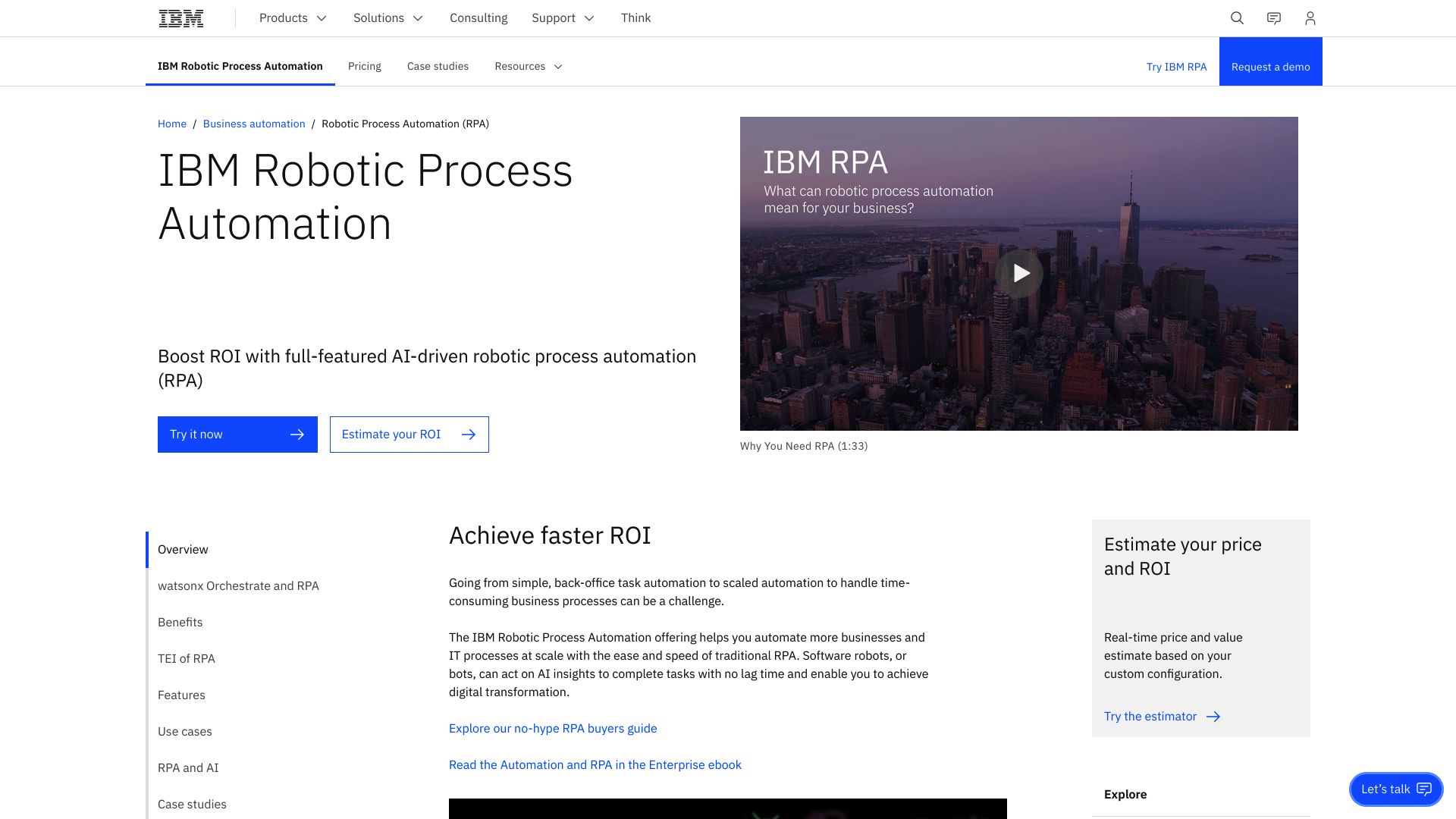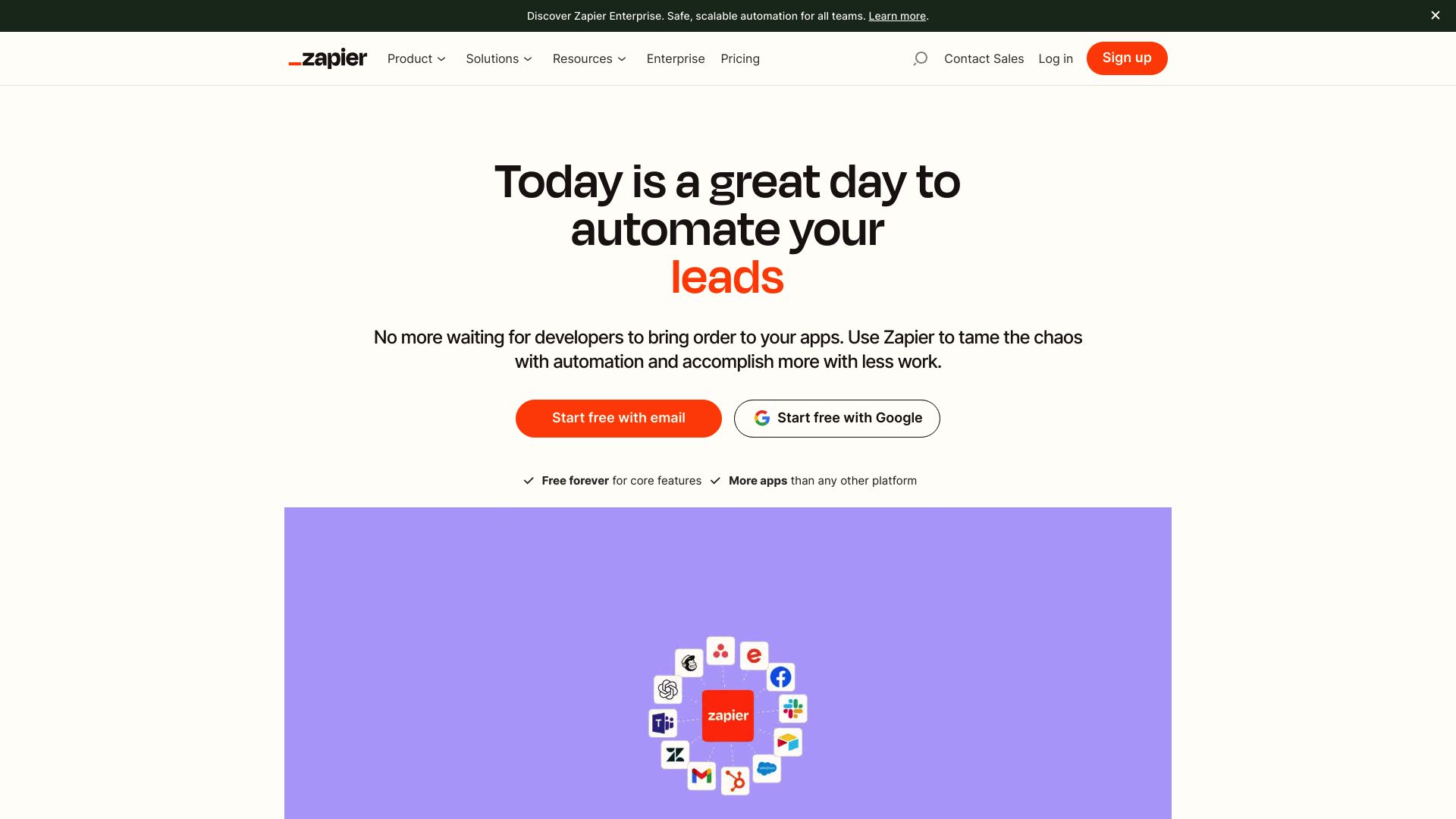IBM RPA vs. Zapier: AI-Driven Automation Showdown
AI-powered automation reshapes business processes, offering unprecedented efficiency and innovation. Our comparison of IBM RPA vs. Zapier, and SmythOS illuminates key differences in enterprise-grade capabilities, integration breadth, and AI sophistication. We explore how each platform tackles workflow automation, from IBM RPA’s robust enterprise focus to Zapier’s user-friendly app connections.
SmythOS emerges as a game-changer, blending advanced AI agents with unmatched deployment flexibility. This analysis equips decision-makers, developers, and business users with insights to select the ideal automation solution for their unique needs, whether streamlining operations, enhancing productivity, or pushing the boundaries of AI-driven workflows.
IBM RPA Overview
IBM Robotic Process Automation (RPA) empowers businesses to automate repetitive digital tasks across enterprise systems. The platform combines AI-driven automation with robust management tools, enabling organizations to build, deploy, and monitor software bots that mimic human interactions with digital systems.
IBM RPA’s core strength lies in its enterprise-grade capabilities. The platform offers a visual, low-code bot builder that allows both technical and non-technical users to create automation workflows through drag-and-drop interfaces. This accessibility democratizes automation, enabling wider adoption across organizations. For more complex scenarios, IBM RPA integrates with IBM watsonx Orchestrate, infusing AI-powered decision-making into automated processes.


The platform shines in its ability to integrate with common enterprise applications like SAP, Office, Java-based systems, and web applications. This versatility allows organizations to automate workflows across diverse technology stacks, maximizing efficiency gains. IBM RPA supports both attended and unattended bots, catering to scenarios that require human oversight and those that can run autonomously.
The platform supports distributed runtime environments and orchestration processes, allowing businesses to scale their automation initiatives effectively.
Scalability stands out as a key feature of IBM RPA. The platform supports distributed runtime environments and orchestration processes, allowing businesses to scale their automation initiatives effectively. This scalability, combined with robust security features and compliance tools, makes IBM RPA particularly attractive for large enterprises with complex IT landscapes and stringent regulatory requirements.
While IBM RPA offers powerful capabilities, its enterprise focus may present a steeper learning curve for smaller organizations or individual developers. The platform’s strengths in security, scalability, and integration with enterprise systems come with added complexity that might be overkill for simpler automation needs. Additionally, pricing for IBM RPA may be less transparent and potentially more expensive compared to some competitors, potentially limiting its accessibility for smaller businesses or startups.
Zapier Overview
Zapier streamlines workflow automation by connecting over 6,000 apps and services. This platform empowers users to create custom automated workflows, called Zaps, without coding expertise. Businesses leverage Zapier to boost productivity, reduce manual tasks, and integrate disparate systems seamlessly.
Zapier’s core functionality revolves around triggers and actions. When a specified event occurs in one app, it automatically initiates a corresponding action in another. This capability proves invaluable for tasks like syncing customer data across platforms, automating social media posts, or streamlining project management workflows.
Zapier streamlines workflow automation by connecting over 6,000 apps and services … without coding expertise.


The platform’s intuitive visual builder simplifies the creation of complex integrations. Users can craft multi-step Zaps, incorporating conditional logic and data transformation. This flexibility allows for sophisticated automation scenarios tailored to specific business needs.
Zapier’s extensive app library sets it apart, offering pre-built integrations with popular services across various categories. This breadth of connections enables users to automate workflows spanning CRM, marketing, finance, and more. While Zapier excels in app integration, it lacks native AI agent capabilities, limiting its potential for more advanced, intelligent automation scenarios.
Zapier’s extensive app library sets it apart, offering pre-built integrations with popular services across various categories.
Scalability remains a key strength of Zapier, with plans catering to individual users, small teams, and large enterprises. However, users requiring deep customization or AI-driven automation may find the platform’s capabilities somewhat constrained. Despite these limitations, Zapier’s user-friendly interface and vast integration options make it a compelling choice for businesses seeking to optimize their digital workflows and boost operational efficiency.
Feature Comparison
IBM RPA and Zapier offer distinct approaches to automation, with key differences in their core components and security features. IBM RPA provides robust enterprise-grade capabilities, including AI-driven automation through integration with watsonx Orchestrate. This allows for sophisticated decision-making and problem-solving within automated processes. In contrast, Zapier focuses on connecting disparate apps and services, lacking native AI agent capabilities.
Security-wise, IBM RPA excels with features like data encryption, OAuth integration, and IP control, catering to stringent enterprise requirements. Zapier, while secure, does not offer the same depth of security options, potentially limiting its suitability for highly regulated industries. IBM RPA’s integration with IBM OpenPages for governance and compliance further widens this gap, providing a level of transparency and auditability that Zapier does not match.
These differences highlight IBM RPA’s strengths in complex, AI-driven enterprise automation scenarios, while Zapier shines in its simplicity and breadth of app integrations for more straightforward workflow automation tasks.
Feature Comparison Table
| IBM RPA | Zapier | SmythOS | |
|---|---|---|---|
| CORE FEATURES | |||
| AI Agents | ❌ | ❌ | ✅ |
| Hosted Agents (Dev, Production) | ✅ | ❌ | ✅ |
| Memory & Context | ❌ | ❌ | ✅ |
| Autonomous Agents | ❌ | ❌ | ✅ |
| Explainability & Transparency | ❌ | ❌ | ✅ |
| Multimodal | ❌ | ❌ | ✅ |
| Problem-Solving Capabilities | ❌ | ❌ | ✅ |
| Multi-Agent Collaboration | ❌ | ❌ | ✅ |
| Human-AI Interaction | ✅ | ❌ | ✅ |
| Work as Team | ❌ | ✅ | ✅ |
| Agent Work Scheduler | ✅ | ❌ | ✅ |
| SECURITY | |||
| Constrained Alignment | ❌ | ❌ | ✅ |
| OAuth | ❌ | ✅ | ✅ |
| IP Control | ❌ | ❌ | ✅ |
| COMPONENTS | |||
| Foundation AIs | ❌ | ❌ | ✅ |
| Huggingface AIs | ❌ | ❌ | ✅ |
| Zapier APIs | ❌ | ✅ | ✅ |
| Classifiers | ❌ | ❌ | ✅ |
| Logic | ✅ | ❌ | ✅ |
| Data Lakes | ❌ | ❌ | ✅ |
| DEPLOYMENT OPTIONS (EMBODIMENTS) | |||
| Deploy as Webhook | ❌ | ✅ | ✅ |
| Staging Domains | ❌ | ✅ | ✅ |
| Production Domains | ❌ | ✅ | ✅ |
| API Authentication (OAuth + Key) | ❌ | ✅ | ✅ |
| Deploy as Site Chat | ❌ | ❌ | ✅ |
| Deploy as Scheduled Agent | ✅ | ❌ | ✅ |
| Deploy as GPT | ❌ | ❌ | ✅ |
| DATA LAKE SUPPORT | |||
| Hosted Vector Database | ❌ | ❌ | ✅ |
| Sitemap Crawler | ❌ | ❌ | ✅ |
| YouTube Transcript Crawler | ❌ | ❌ | ✅ |
| URL Crawler | ❌ | ❌ | ✅ |
| PDF Support | ✅ | ❌ | ✅ |
| Word File Support | ✅ | ❌ | ✅ |
| TXT File Support | ✅ | ❌ | ✅ |
Best Alternative to IBM RPA and Zapier
SmythOS stands out as the superior alternative to IBM RPA and Zapier, offering a comprehensive AI agent development platform that combines ease of use with powerful features. Our drag-and-drop interface democratizes AI creation, allowing users of all skill levels to build sophisticated agents without extensive coding knowledge.
Unlike IBM RPA and Zapier, SmythOS provides true AI capabilities, enabling the creation of autonomous agents that can handle complex tasks, learn from interactions, and make intelligent decisions. This expands the potential use cases far beyond simple automation, opening up new possibilities for businesses across industries.
SmythOS provides true AI capabilities, enabling the creation of autonomous agents that can handle complex tasks, learn from interactions, and make intelligent decisions.
We offer unparalleled flexibility in deployment options. SmythOS agents can be integrated as APIs, webhooks, chatbots, or even GPT models, adapting to your specific needs. This versatility surpasses the limited deployment options of both IBM RPA and Zapier.
Security is a top priority in SmythOS. We implement robust measures like data encryption, OAuth integration, and IP control, meeting enterprise-grade standards that Zapier lacks. Our platform also excels in scalability, easily handling growing workloads without compromising performance – a critical advantage over both competitors.
By choosing SmythOS, you’re not just getting an automation tool; you’re gaining a powerful AI ecosystem that can transform your business processes, drive innovation, and unlock new efficiencies across your organization.
Conclusion
IBM RPA and Zapier offer powerful automation solutions, each with distinct strengths. IBM RPA excels in enterprise-grade capabilities, providing AI-driven automation and robust security features ideal for large organizations with complex IT landscapes. Zapier shines in its simplicity and vast app integration library, making it a go-to choice for streamlining workflows across popular services.
However, SmythOS emerges as the superior option, combining the best of both worlds and pushing the boundaries of AI-powered automation. Our platform offers unparalleled flexibility, allowing users to create sophisticated AI agents using a visual, drag-and-drop interface. Unlike Zapier, SmythOS provides native AI capabilities, enabling intelligent decision-making and problem-solving within automated processes.
SmythOS stands out with its “Create Once, Deploy Anywhere” approach, surpassing IBM RPA’s deployment options. We empower users to integrate AI agents seamlessly across various platforms, from chatbots to APIs, and even as ChatGPT plugins. This versatility, combined with our extensive integration ecosystem of over 300,000 connections, positions SmythOS as the most adaptable and powerful automation solution in the market.
Experience the future of AI-powered automation with SmythOS. Create a free account today and discover how our platform can revolutionize your workflow. With unlimited agents, a 30-day money-back guarantee, and the ability to automate complex tasks effortlessly, SmythOS is your gateway to unlocking unprecedented productivity and innovation.
Last updated:
Disclaimer: The information presented in this article is for general informational purposes only and is provided as is. While we strive to keep the content up-to-date and accurate, we make no representations or warranties of any kind, express or implied, about the completeness, accuracy, reliability, suitability, or availability of the information contained in this article.
Any reliance you place on such information is strictly at your own risk. We reserve the right to make additions, deletions, or modifications to the contents of this article at any time without prior notice.
In no event will we be liable for any loss or damage including without limitation, indirect or consequential loss or damage, or any loss or damage whatsoever arising from loss of data, profits, or any other loss not specified herein arising out of, or in connection with, the use of this article.
Despite our best efforts, this article may contain oversights, errors, or omissions. If you notice any inaccuracies or have concerns about the content, please report them through our content feedback form. Your input helps us maintain the quality and reliability of our information.
